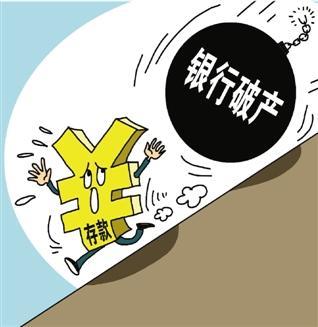Headline Q&A – What happens to our deposits when the bank fails? Picture from Toutiao Q&A-Today’s Toutiao
Since the explosion of Henan Rural Banks in early June this year, a large number of troubled banks have emerged in China. Among them, not only small and medium-sized banks, but even the Industrial and Commercial Bank of China has also been run. Due to the impact of the real estate subprime mortgage crisis, the vast majority of small and medium-sized banks are facing bankruptcy, and the intensification of bank runs has accelerated the failure of these small and medium-sized banks.
China’s subprime mortgage crisis has already surpassed the international warning line
According to a report by the Nikkei Chinese website on December 20, 2021, the net assets of the world as a whole will reach US$510 trillion in 2020, a three-fold increase from US$160 trillion in 2000. Among them, China has soared from 7 trillion US dollars in 2000 to 120 trillion US dollars, an increase of 17.1 times, and 14 times higher than the international average growth.
According to the “Report on China’s Housing Stock: 2021”, in 2020, the market value of China’s housing will be US$62.6 trillion (about 445 trillion yuan) , accounting for 52.16% of the country’s total wealth of US$120 trillion. In the same year, the housing market value of the United States was US$33.6 trillion, accounting for 37.78% of the country’s total wealth; Japan’s US$10.8 trillion, accounting for 30.85% of the country’s total wealth; the combined market value of housing in Britain, France and Germany was only US$31.5 trillion.
From the perspective of the ratio of housing market value to GDP, in 2020, China’s GDP will be 14.72 trillion US dollars, and the ratio of housing market value to GDP will be 414%. In the same year, it was 148% in the US, 233% in Japan, 271% in Germany, 339% in the UK and 354% in France. Before the subprime mortgage crisis broke out in 2008, the ratio of housing market value to GDP in the United States was as high as 169%. Before Japan’s real estate bubble burst in 1991, Japan’s housing market value to GDP ratio was at its highest at 391%.
China’s subprime mortgage crisis has already surpassed the international warning line. Starting from 2020, the ratio of China’s housing market value to GDP is 245% higher than that before the subprime mortgage crisis in the United States, and 23% higher than that before Japan’s real estate bubble burst. The reason why China’s real estate bubble has yet to burst is mainly due to the government’s policy intervention to survive until today. However, due to the closure of the city due to the epidemic and the closure of private enterprises, the wave of supply interruptions by owners has already exceeded the risk capacity of banks, and this wave of supply interruptions has only just begun.
China has become the world’s largest indebted country
According to China’s official data, by the end of 2021, there will be 4,602 banks nationwide, with more than 200,000 bank outlets. Among them, there are 1 development financial institution, 2 policy banks, 6 state-owned banks, 12 joint-stock banks, 128 city commercial banks, 19 private banks, 41 foreign-funded banks, 1,595 rural commercial banks, and 23 rural cooperative banks. , 577 rural credit cooperatives, 1651 village and town banks, etc. Except for state-owned banks, almost 90% belong to local small and medium-sized banks .
According to figures released by the World Bank, in 2021, the global debt scale will surge to 303 trillion US dollars, of which China’s total debt is 336 trillion yuan (about 50.1 trillion US dollars) . According to the macroeconomic leverage ratio, in 2021, China’s GDP will be 114 trillion, and the leverage ratio will be 296%. In the same year, Japan’s leverage ratio was 115.6% and the US was 84.6%. Few of the developing world’s leverage ratios exceed 70%, while China is 226% above the warning line. It can be seen that China has become a veritable indebted country in the world.
The total national debt mainly includes government debt, household debt and corporate debt. According to a report by Goldman Sachs, by the end of 2021, China’s total debt is US$50.1 trillion, of which total government debt is US$11.3 trillion (US$3.4 trillion in national debt and US$7.9 trillion in local government debt); $30 trillion (more than 80% of which is mortgage loans); total corporate debt is about $8.8 trillion (60% of which is real estate corporate debt).
Small and medium banks are the root cause of the subprime mortgage crisis
According to the internal sampling analysis of the banking industry, the sources of funds for small and medium-sized banks in China are: State-owned banks’ on-lending accounts for about 80%, investment by bank investors accounts for about 5%, and residents’ deposits account for about 15%. Of the total size of the so-called bank deposits, 80% of which are converted from loans to deposits, and these so-called depositors are all lenders. In other words, once small and medium-sized banks fail, the biggest losses are still state-owned banks.
Small and medium banks are the root cause of the subprime mortgage crisis. The main loan objects of small and medium-sized banks fall into three categories: First, loans from local government financing platforms. Now that local governments can’t even pay wages, how can they have the money to repay bank loans? The second is private enterprise loans. Among them, more than 60% of private enterprise loans have flowed into the real estate market. Due to the Great Depression in the real estate market, more than 90% of real estate enterprises are facing a crisis of survival. Bank loans can only be used to repay debts. car loan. In recent years, due to the tide of foreign capital escaping, the tide of private enterprises closing down, the tide of city closures due to the epidemic, the tide of social unemployment, the tide of real estate price cuts, and the tide of employee salary cuts, etc., the repayment ability of individual residents has also greatly decreased, and the supply of housing and car loans has been cut off. The tide came one after another.
In this context, almost 80% of the loans issued by small and medium-sized banks have become subprime loans. Once there is a run on similar banks, a domino effect will soon form, and the entire small and medium-sized banks will be affected. According to incomplete statistics, at present, hundreds of rural banks in China are facing bankruptcy and liquidation, and the phenomenon of running on small and medium-sized banks in various places is still worsening. Some experts believe that according to the current economic situation in China, it is expected that by the end of this year, the vast majority of small and medium-sized banks will have an existential crisis, and the failure of a large number of small and medium-sized banks will inevitably trigger an economic crisis in China. Therefore, the collapse of small and medium-sized banks today is just the beginning.
(This article only represents the author’s personal views and positions, please indicate the source for reprinting, thank you)


